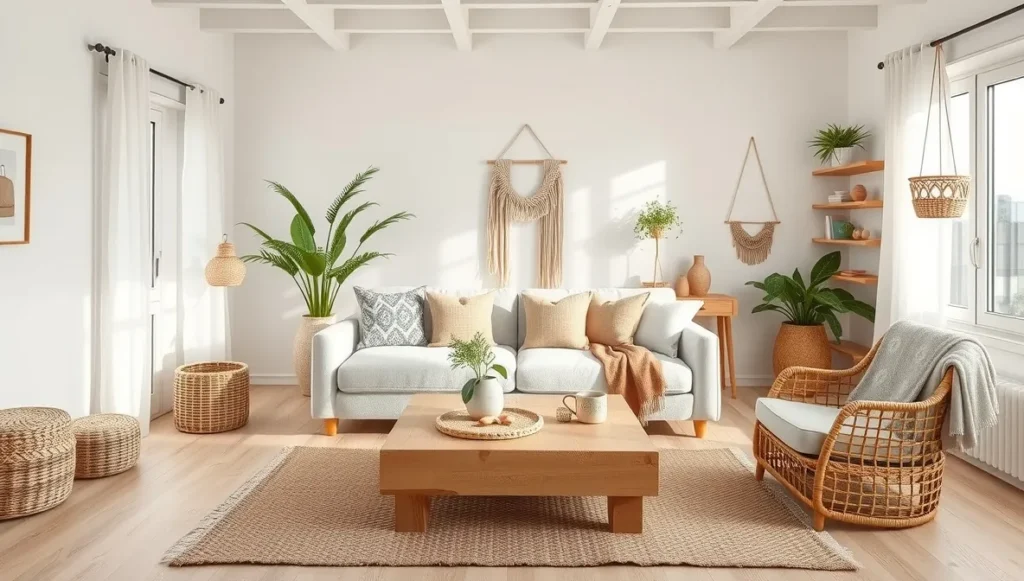- The Unexpected Magic of Boho Scandi: Why This Fusion Style is Taking Over Modern Homes - September 2, 2025
- Japandi Design: Why This Japanese-Scandinavian Hybrid Has Taken Over My Client Projects - September 2, 2025
- The Real Story Behind Transitional Interior Design: Why It Actually Works - September 1, 2025
Table of Contents
Twelve years into my design career, I’ve seen trends that promised to revolutionize our homes, only to disappear faster than you can say “farmhouse chic.” But Boho Scandi? This one’s different. It has staying power, and frankly, it surprised me.
My first real encounter with this style happened in 2018. A client in Copenhagen invited me to see her newly renovated apartment before we started working together. Walking into that space – crisp white walls dotted with woven baskets, a vintage Persian rug sprawled under a sleek Danish dining table – something clicked. How had someone made bohemian maximalism play so nicely with Scandinavian restraint?
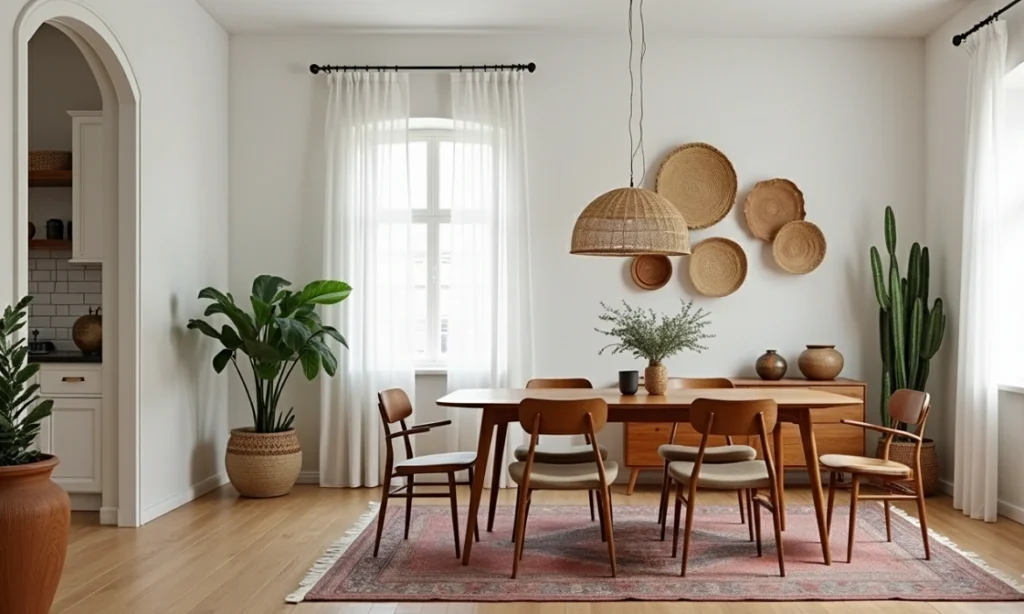
The Contradiction That Actually Works
Here’s the thing about Boho Scandi: it shouldn’t work. Traditional Scandinavian design is all about “lagom” – that Swedish concept of having just enough. Clean lines, muted colors, function over form. Bohemian design celebrates the opposite – more is more, patterns clash beautifully, every surface tells a story.
Yet somehow, when you take the structural bones of Nordic design and dress them up with carefully chosen boho elements, magic happens. I’ve guided over 200 families through this process now, and the results consistently surprise everyone involved.
The secret isn’t cramming dreamcatchers into an IKEA showroom. It’s about understanding which elements from each style can coexist without fighting for attention.
Building Your Foundation (The Nordic Way)
Every successful Boho Scandi room starts boring. Sorry, but it’s true. You need those clean Scandinavian bones first – neutral walls, simple furniture silhouettes, plenty of natural light. Think of it as building a gallery space for your personality to shine later.
I usually steer clients toward warm whites for walls. Benjamin Moore’s Cloud White gets recommended a lot in my practice, though Farrow & Ball’s Pointing works beautifully too. For flooring, light oak or birch creates that quintessential Nordic vibe.
The Three-Layer Boho Integration
Layer One: Textiles (Your Gateway Drug)
Textiles bridge these two worlds better than anything else. Start conservative – a large jute or wool rug in cream or soft gray gives you that Scandi foundation. Then things get interesting.
Smaller rugs become your playground. Persian runners, Moroccan boucherouite rugs, vintage kilims – these add the wanderlust element bohemian style craves. Just remember scale matters. Mix large patterns with smaller ones, geometric with organic.
A client in San Francisco was terrified of mixing patterns until we layered her grandmother’s worn Persian runner over a simple jute rug. The combination transformed her sterile living room into something that felt collected over decades, not bought in an afternoon.
Throw pillows let you experiment with color without commitment. Dusty rose, sage green, ochre yellow – but always in natural fabrics. Linen wrinkles beautifully. Cotton breathes. Avoid anything too shiny or synthetic. Here’s the picture of San Francisco living room..
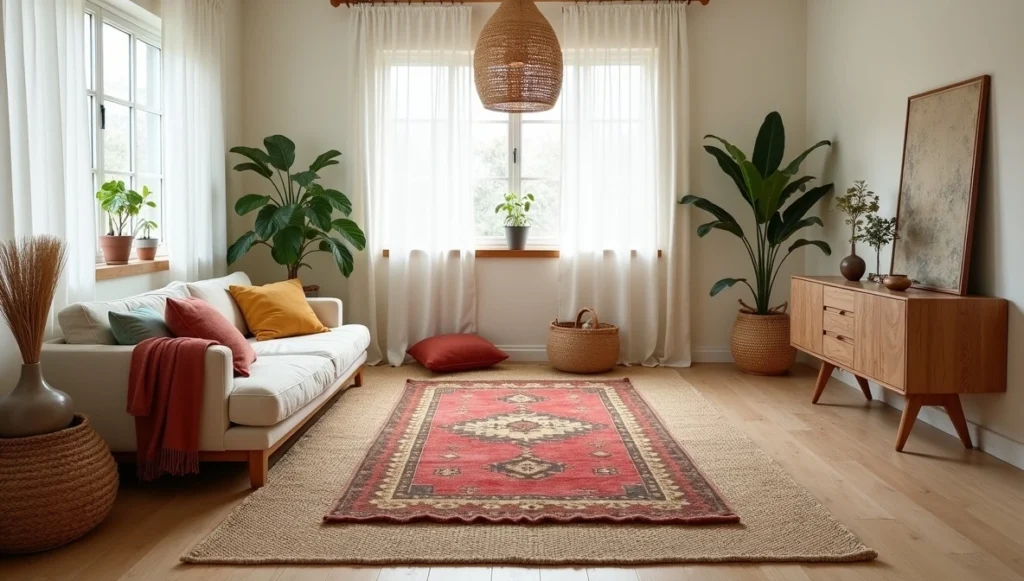
Layer Two: Plants (Lots of Them)
Scandinavians love their plants, but they’re usually content with one dramatic fiddle leaf fig or a single orchid on the windowsill. Boho Scandi says “why choose?”
Hanging plants work wonders here. Pothos trailing from macramé hangers, air plants in geometric holders, trailing philodendrons cascading from floating shelves. But keep the hangers themselves clean-lined – think modern macramé, not 1970s craft fair.
Floor plants anchor corners beautifully. Bird of paradise for drama, snake plants for low-maintenance greenery, or a cluster of different sized plants in matching white planters.
One mistake I see constantly? People forget about herbs. A windowsill lined with small potted herbs in simple terracotta pots looks intentional and lived-in while serving a practical purpose.
Layer Three: Curated Collections
This layer separates amateur attempts from spaces that look professionally designed. Travel souvenirs, art pieces, books, ceramics – they all have a place, but curation matters more than quantity.
Group items in odd numbers. Vary heights for visual interest. Leave breathing room between objects – your Scandinavian foundation demands it.
I learned this lesson the hard way during a project in Austin three years ago. My client was a world traveler with incredible pottery from every continent. My first instinct was to display everything. The room looked like a museum storage facility. We edited ruthlessly, rotating pieces seasonally. Suddenly, each remaining piece had space to be appreciated.
Room-by-Room Reality Check
Living Rooms: Where Everything Comes Together
Living rooms handle the most Boho Scandi elements gracefully. Start with neutral seating – I’m partial to IKEA’s Ekeskog in natural linen because it’s both affordable and timeless. Layer it generously with textured throws and patterned cushions.
Gallery walls work beautifully here, but composition matters. Mix black-and-white photography with small woven pieces, maybe some dried flowers or branches. The gallery wall I created for my Seattle clients last year combined family photos with vintage postcards and three small woven baskets. The trick was maintaining generous white space between elements.
Coffee tables should multitask. Simple wooden surfaces with woven storage baskets underneath keep clutter hidden while adding texture. Style the surface minimally – books, one plant, perhaps a meaningful ceramic piece. Resist the Instagram urge to overcrowd.
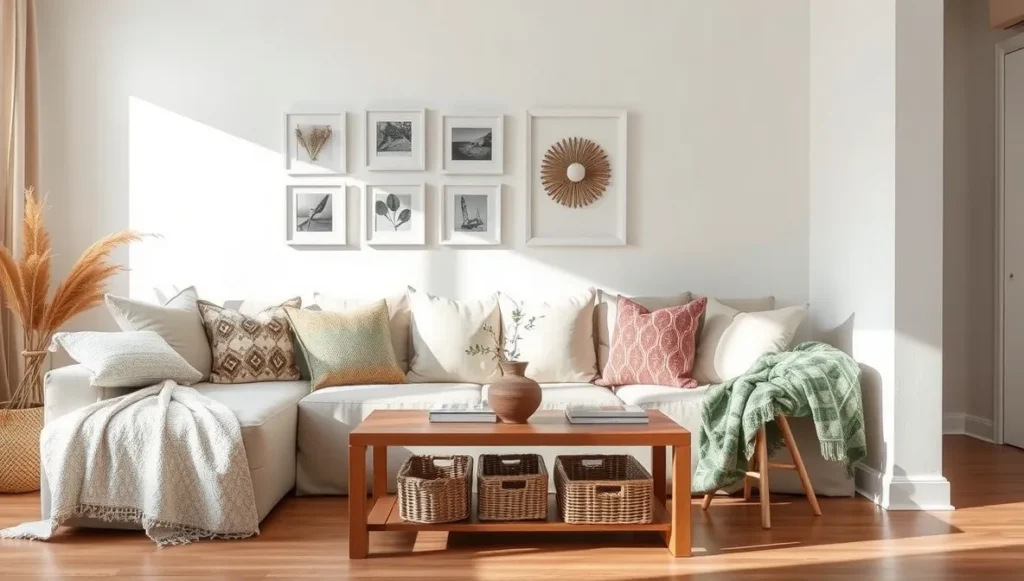
Bedrooms: Keep It Calm
Bedrooms require restraint. Too many boho elements disrupt the serenity essential for good sleep. I always start with white or natural linen bedding – splurge here if your budget allows, because daily tactile pleasure matters.
Add texture through a chunky knit throw or macramé wall hanging above the headboard. One technique that works beautifully is what I call “collected over time” styling. Display vintage books on floating shelves, add a small plant to the nightstand, include one statement piece – maybe a Moroccan mirror or ceramic lamp with history behind it.
The bedroom I designed in Austin featured the simplest possible wooden bed frame with a small kilim rug at the foot and dried eucalyptus in a ceramic vase. Nothing groundbreaking, but it felt peaceful and personal.
Lighting makes or breaks bedroom ambiance. Harsh overhead fixtures kill the mood instantly. Bedside pendant lights or warm-toned table lamps create the soft atmosphere this style needs.
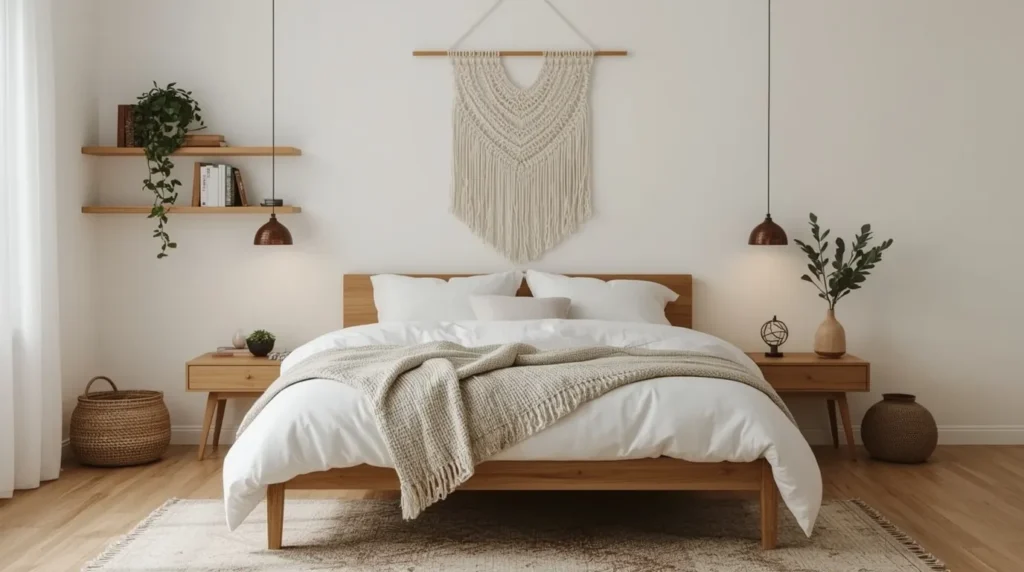
Kitchens: Personality Within Practicality
Most people inherit white kitchen cabinets, and that’s actually perfect for this style. Focus energy on open shelving styling instead of major renovations.
Mix white dishes with wooden cutting boards, woven baskets for storage, and pottery pieces in earthy tones. Hanging plants thrive in kitchen environments – herbs in macramé hangers near windows, trailing pothos above sinks where they catch indirect light.
My Portland clients added a vintage runner in their galley kitchen and displayed their handmade mug collection on open shelves. The changes cost under $200 but transformed the space from sterile to soulful.
Bar stools offer easy boho integration. Natural rattan or woven seats warm up the clean lines without overwhelming them.
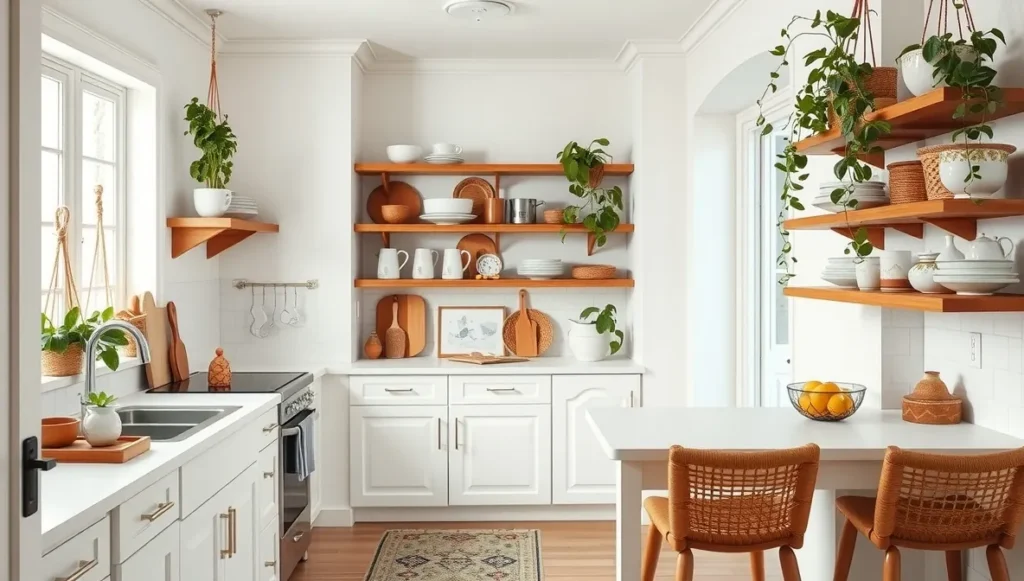
Dining Rooms: Mixing With Purpose
Dining rooms let you experiment more boldly. Simple wooden tables (light oak works best) paired with mismatched chairs create visual interest while maintaining functionality.
Statement lighting fixtures have big impact here. Woven pendants or even a series of hanging plants at varying heights above the table draw the eye upward and create intimate atmosphere.
One recent project featured a built-in bench with bohemian-style cushions alongside simple wooden chairs. The seating variety felt casual and welcoming while the clean lines prevented visual chaos.
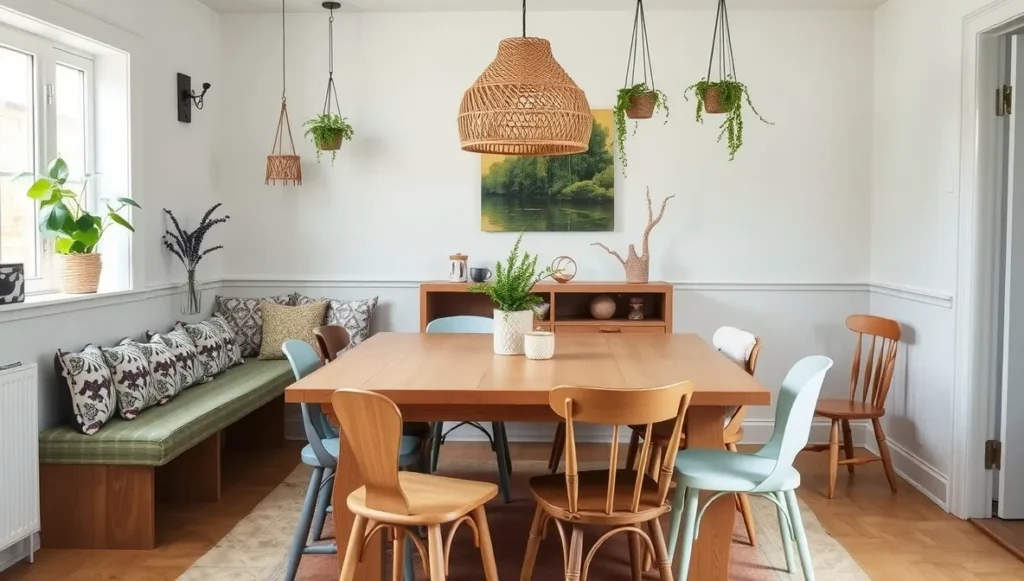
Bathrooms: Small Changes, Big Impact
Even tiny bathrooms can embrace this aesthetic. Start with the Scandinavian preference for white tiles and simple fixtures, then add warmth through natural textures.
Woven baskets hide toiletries beautifully. Plants that handle humidity well – snake plants are nearly indestructible – add life to sterile spaces. Organic cotton towels in muted colors feel luxurious against skin.
For a Denver client, we hung a macramé plant holder in the corner with a trailing plant. That single addition shifted the entire room’s energy without any construction work.
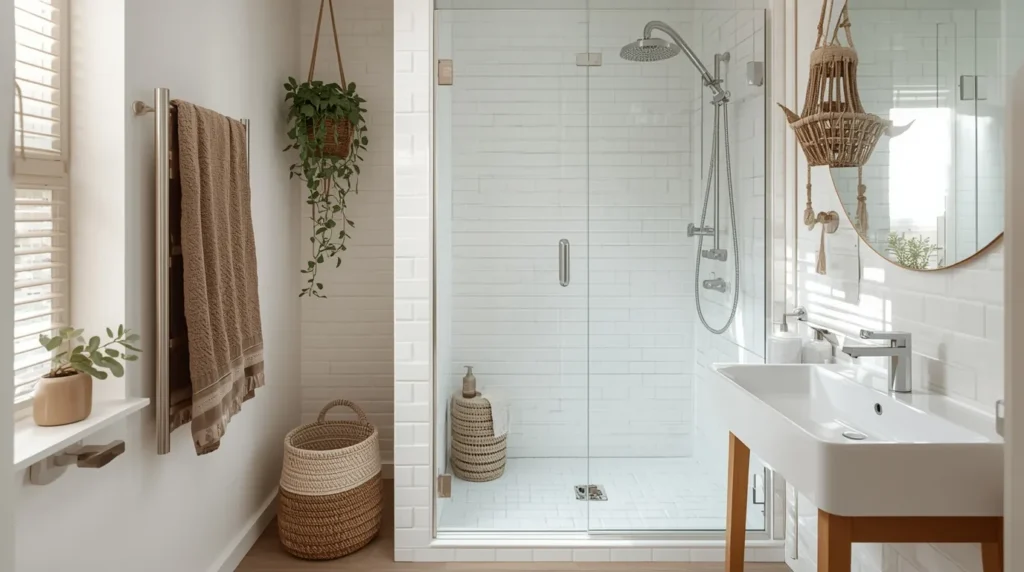
Home Offices: Focus Meets Creativity
Remote work changed everything about home office design. People need spaces that encourage focus while inspiring creativity – perfect territory for Boho Scandi.
Clean-lined desks (white or light wood) provide the structure, while chair choice adds personality. Natural rattan or cushioned seats in subtle patterns work well.
Plants boost both air quality and mood. Large floor plants anchor corners while smaller desk plants bring life to work surfaces without creating distraction.
Storage should hide clutter while adding texture. Woven baskets or simple wooden boxes maintain the aesthetic while serving practical needs.
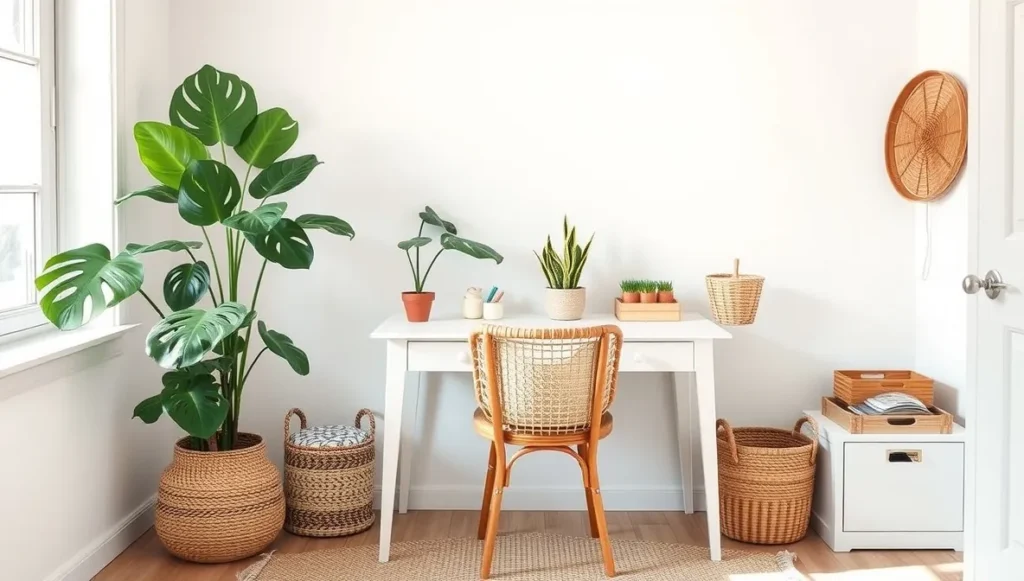
Kids’ Rooms: Style That Grows
Parents worry this style won’t work for children, but I disagree. The Scandinavian foundation of simple, quality furniture grows with kids, while boho elements adapt as they age.
Neutral walls and a sturdy wooden bed frame provide longevity, giving the room a solid anchor piece that can transition as children grow. Around it, personality comes through easily changeable textiles – colorful rugs, fun cushions, and artwork hung at child height.
For a Minneapolis client, we combined a simple wooden bed with a cozy reading nook made of natural fabric floor cushions and a small bookshelf styled with plants and wooden toys. As her daughter grows, updating bedding, textiles, and accessories will keep the space current while preserving the foundational investment.
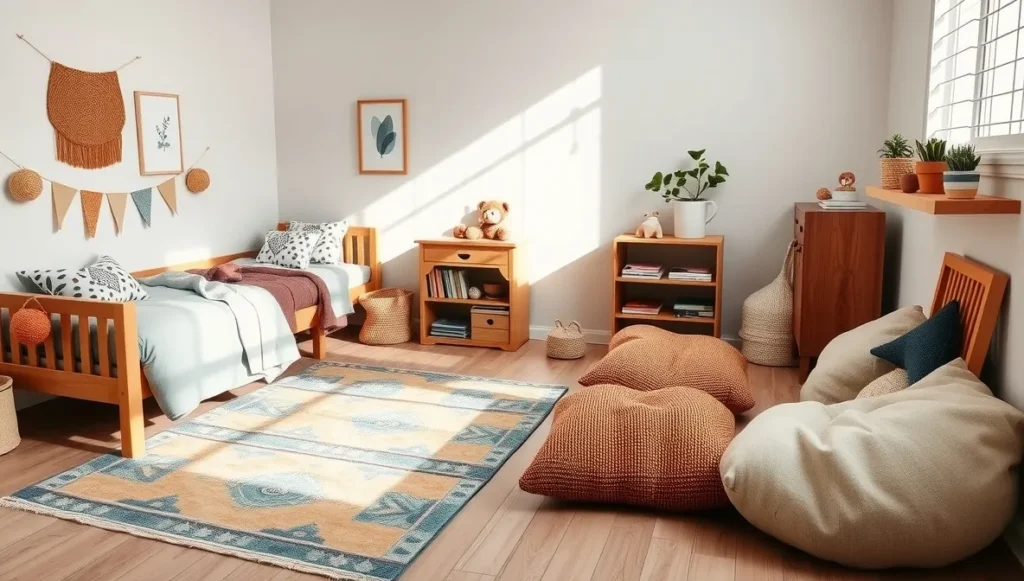
Mistakes That Kill the Look
After troubleshooting countless Boho Scandi attempts, certain problems appear repeatedly:
Surface Overcrowding: Bohemian abundance doesn’t mean every surface needs decoration. Negative space matters – your Nordic foundation requires it for visual breathing room.
Wrong Lighting: Scandinavian design depends on natural light and warm artificial alternatives. Harsh fluorescents or overly colored bulbs destroy the serene atmosphere you’re building.
Form Over Function: Every element should serve a purpose. Beautiful Moroccan poufs need to be comfortable for actual sitting. Vintage trunks should offer real storage. If it’s just decorative, question whether you need it.
Color Chaos: Boho doesn scandi doesn’t mean rainbow explosion. Stick to a cohesive palette – warm whites, soft grays, muted earth tones, with occasional deeper accents.
Why This Style Actually Works
Families choose Boho Scandi because it delivers something rare – spaces that photograph well for social media but function beautifully for daily life. Children can play without destroying the aesthetic. Guests feel immediately comfortable. The style reflects personality without sacrificing sophistication.
Three years later, I revisited a family whose living room we’d designed together. Despite daily abuse from two young children and a large dog, the space looked almost identical to our completion photos. Durable natural materials and thoughtful layouts survive real family life.
Budget-Friendly Implementation
One thing I love about this style is its accessibility. You don’t need expensive furniture to achieve the look. Some of my most successful projects combined IKEA basics with vintage finds and DIY elements.
Start with secondhand furniture you can refresh with light staining or white paint. Hunt for textiles at local markets or online vintage shops. Many clients’ favorite pieces cost under $50 but look expensive because of thoughtful placement and styling.
Thrift stores are goldmines for ceramic pieces, woven baskets, and interesting art. Estate sales often yield beautiful rugs at fraction of retail prices. Facebook Marketplace has become my secret weapon for finding unique pieces.
Looking Forward
This style continues evolving toward more sustainable practices. Reclaimed wood, locally-made ceramics, and fair-trade textiles are becoming standard requests from environmentally conscious clients.
The core appeal remains constant though – spaces that feel worldly yet peaceful, collected yet curated, lived-in yet loved. In our increasingly chaotic world, homes that offer both stimulation and serenity serve essential psychological needs.
Starting Your Own Boho Scandi Journey
Ready to try this in your own space? Start small and build confidence. Add a vintage rug to your minimalist living room. Introduce plants and natural textures gradually. Replace harsh overhead lighting with warm, ambient alternatives.
Great design isn’t about perfectly following any rulebook – it’s about creating spaces that support how you actually live. Boho Scandi succeeds because it honors both our need for calm and our desire for character. That combination never gets old.
